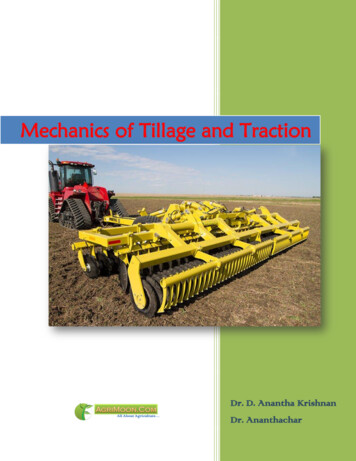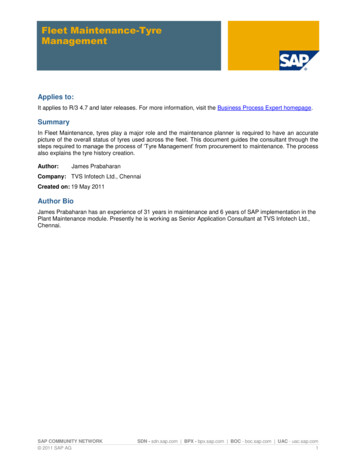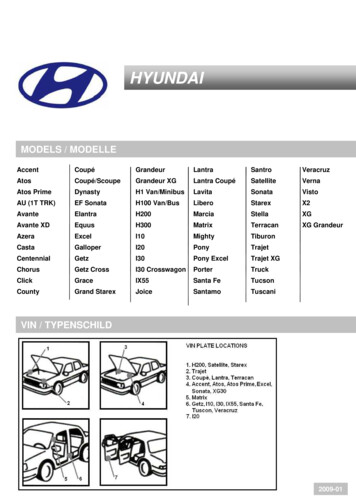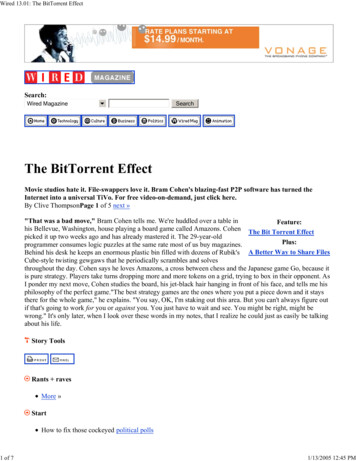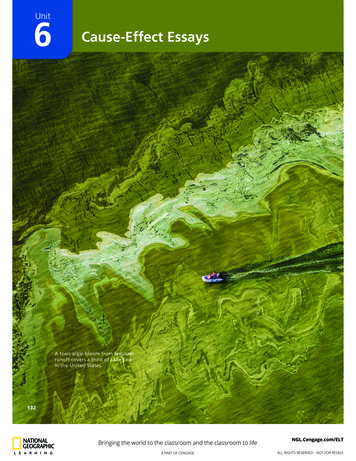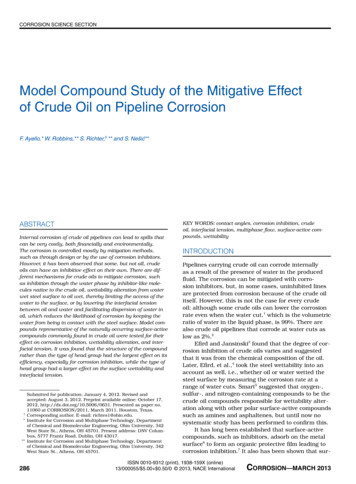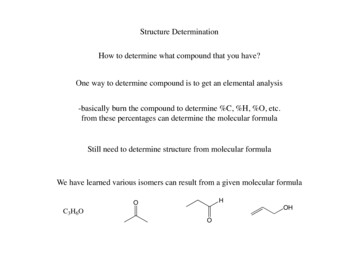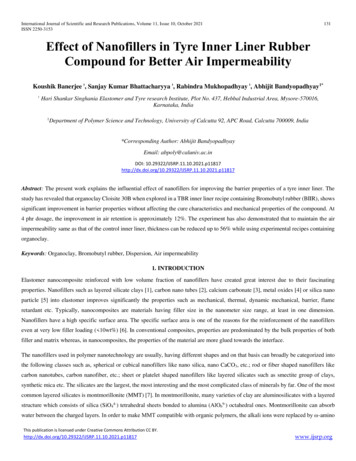
Transcription
International Journal of Scientific and Research Publications, Volume 11, Issue 10, October 2021ISSN 2250-3153131Effect of Nanofillers in Tyre Inner Liner RubberCompound for Better Air ImpermeabilityKoushik Banerjee ǂ, Sanjay Kumar Bhattacharyya ǂ, Rabindra Mukhopadhyay ǂ, Abhijit Bandyopadhyay1*ǂHari Shankar Singhania Elastomer and Tyre research Institute, Plot No. 437, Hebbal Industrial Area, Mysore-570016,Karnataka, India1Department of Polymer Science and Technology, University of Calcutta 92, APC Road, Calcutta 700009, India*Corresponding Author: Abhijit BandyopadhyayEmail: abpoly@caluniv.ac.inDOI: 10.29322/IJSRP.11.10.2021.p11817Abstract: The present work explains the influential effect of nanofillers for improving the barrier properties of a tyre inner liner. Thestudy has revealed that organoclay Cloisite 30B when explored in a TBR inner liner recipe containing Bromobutyl rubber (BIIR), showssignificant improvement in barrier properties without affecting the cure characteristics and mechanical properties of the compound. At4 phr dosage, the improvement in air retention is approximately 12%. The experiment has also demonstrated that to maintain the airimpermeability same as that of the control inner liner, thickness can be reduced up to 56% while using experimental recipes containingorganoclay.Keywords: Organoclay, Bromobutyl rubber, Dispersion, Air impermeability1. INTRODUCTIONElastomer nanocomposite reinforced with low volume fraction of nanofillers have created great interest due to their fascinatingproperties. Nanofillers such as layered silicate clays [1], carbon nano tubes [2], calcium carbonate [3], metal oxides [4] or silica nanoparticle [5] into elastomer improves significantly the properties such as mechanical, thermal, dynamic mechanical, barrier, flameretardant etc. Typically, nanocomposites are materials having filler size in the nanometer size range, at least in one dimension.Nanofillers have a high specific surface area. The specific surface area is one of the reasons for the reinforcement of the nanofillerseven at very low filler loading ( 10wt%) [6]. In conventional composites, properties are predominated by the bulk properties of bothfiller and matrix whereas, in nanocomposites, the properties of the material are more glued towards the interface.The nanofillers used in polymer nanotechnology are usually, having different shapes and on that basis can broadly be categorized intothe following classes such as, spherical or cubical nanofillers like nano silica, nano CaCO3, etc.; rod or fiber shaped nanofillers likecarbon nanotubes, carbon nanofiber, etc.; sheet or platelet shaped nanofillers like layered silicates such as smectite group of clays,synthetic mica etc. The silicates are the largest, the most interesting and the most complicated class of minerals by far. One of the mostcommon layered silicates is montmorillonite (MMT) [7]. In montmorillonite, many varieties of clay are aluminosilicates with a layeredstructure which consists of silica (SiO44-) tetrahedral sheets bonded to alumina (AlO69-) octahedral ones. Montmorillonite can absorbwater between the charged layers. In order to make MMT compatible with organic polymers, the alkali ions were replaced by ω-aminoThis publication is licensed under Creative Commons Attribution CC 817www.ijsrp.org
International Journal of Scientific and Research Publications, Volume 11, Issue 10, October 2021ISSN 2250-3153132acid hydrochloride salt and organic surfactants, such as alkylammonium and arylphosphonium ion as shown in Fig. 1. The surfactantprovides a hydrophobic nature to the silicate surface, which causes the layers to become organophilic and such clay is known asorganoclay [8]. These surfactant molecules increase the interlayer distance and improve the compatibility with the polymer.Figure 1: Modification of nanoclays with organic aminesThe purpose of a tubeless tyre inner liner is air retention. In conventional composites, air molecules can easily pass through, whereasthey take more time to pass through the nanocomposites. It is believed that the air travelling path formed by the nanoclays are ‘zigzag’,whereas in convectional composites, the path is straight, as shown in Fig. 2. Therefore, in this scope of experiment, two different typesof nanoclays such as Sepiolite (unmodified clay) and Cloisite 30B (modified clay) were experimented in a Truck and Bus Radial (TBR)inner liner recipe and the properties of the nanoclay containing experimental compounds were compared against a control recipe withouthaving nanoclay. Based on the improvements in the air impermeabilities, a possible gauge reduction analysis was done in order maintainthe air retention same as that of the control compound.Figure 2: Comparison of air travelling path in nanocomposite with conventional compositeThis publication is licensed under Creative Commons Attribution CC 817www.ijsrp.org
International Journal of Scientific and Research Publications, Volume 11, Issue 10, October 2021ISSN 2250-31531332. EXPERIMENTAL SECTION2.1. Raw Materials:Bromobutyl rubber (BIIR-2222) of low Mooney grade (Mooney Viscosity 32 MU) was procured from Exxon Mobil ChemicalCompany, USA. Natural rubber, SMR 20 (Mooney Viscosity 85 MU) having a dirt content of 0.2% (maximum) was purchased fromMalaysia. Sepiolite which is a Magnesium silicate clay, was obtained from SKKU minerals, India. Tallow modified Montmorillonitebased organoclay (OMMT), Cloisite 30B, was procured from the Southern Clay, India. The Carbon black, N660 (nitrogen surface area30.5 m2/gm, OAN 90.5 cc/100 gm), was supplied by Hi-Tech Carbon, India. The compounding ingredients such as zinc oxide (ZincO-India), Stearic acid (Godrej Soap Limited, India), Low PCA oil (Raj Petro, Silvasa), Coumarone-Indene Resin (CI Resin) (Bombaychemicals, Pune), Soluble Sulfur (Jain Chemicals Ltd., India) and MBTS (dibenzothiazole disulfide, NOCIL, Thane), were procuredfrom indigenous sources and were used as received.2.2. Rubber Compound Preparation:To study the elastomer-nanoclay interaction and intercalation/exfoliation, the clays were explored in model formulations of TBR andPCR inner liners. The formulations are shown in Table 1.Table 1: Compound Formulations of TBR Inner linerIngredients .00100.00100.00Stearic .00Sepiolite-2.00-4.00-Cloisite 30B--2.00-4.00Low PCA oil5.005.005.005.005.00CI oluble Sulfur0.400.400.400.400.40Zinc 2.70182.70The mixing was performed in a Haake Rheomix laboratory scale mixer (Thermo scientific, USA) equipped with 4-wing rotor and witha chamber volume of 370 cm3.The masterbatches were mixed at a TCU setting of 90 C and at 60 rpm and the final batches were mixed at 30 rpm and 70 C TCUsetting. The mixing duration was 300s. For experimental compounds, initial 240s rubber-clay pre-mastication [9] was given assignificant enhancement was observed. Masterbatch discharge temperature was kept in the range of 115-120 C. The final batches weredischarged between 85-90 C.2.3. Characterization of the rubber compounds:Mooney viscosities, ML (1 4) at100 C were measured using a large rotor Mooney viscometer, MV 2000E, Alpha technologies, USA,following ASTM D 1646. Cure characteristics of the compounds were determined using a Moving die rheometer (P-MDR, Alphatechnologies, USA) following ASTM D 5289. Isothermal curing condition was maintained at 145 C for 60 min. Moulding of thecompounds was performed by compression molding following ASTM D3182 in a hydraulic press (Hind Hydraulics, India). The curingThis publication is licensed under Creative Commons Attribution CC 817www.ijsrp.org
International Journal of Scientific and Research Publications, Volume 11, Issue 10, October 2021ISSN 2250-3153134condition maintained for tensile slabs was 145 C for with two times the tc90 values obtained in rheometer, with a moulding pressure of14.71 MPa. Stress-strain properties of the vulcanizates were checked using Z010 universal testing machine (UTM) from Zwick (UTM,Germany) as per ASTM D412. Dumbbell shaped specimens were used during physical testing (ASTM die – C). Dispersion of nanoclaywas studied in a TEM at 200kv acceleration voltage (Talos-S, FEI, USA). All pictures were taken at 1 micron magnification. Sampleswere cryomicrotomed (Leica Ultracut UCT) at -100 C to a specimen thickness of 100 nm prior to analysis. Air permeability was testedin Prolific Gas Permeability Tester as per IS 3400-21 method.3. RESULTS AND DISCUSSION3.1. Cure Characteristics Measurement:Vulcanization parameters are reported in Table 2. The increase in both minimum (ML) and maximum torque (MH) values in theexperimental compounds signifies higher filler networking in presence of nanoclays. Although there is no significant change in thescorch safety time (ts2) in between the experimental compounds, however the optimum cure time (tc90) has been increased comparedto the control. The nanoclays are primarily consists of silicate layers which makes them acidic in nature. Therefore, the curing time hasincreased in the clay containing compounds. The slowness in the curing is more significant in Sepiolite clay whereas for Cloisite 30B,the effect is less pronounced. Perhaps the presence of organic amines as modifiers in Cloisite 30B somewhat neutralizes the acidity ofthe medium. As a result, the curing reaction was facilitated.Table 2: Cure characteristics of the compoundsRheometric propertiesControlSP-230B-2SP-430B-4ML (lb.in.)1.241.321.251.471.41MH (lb.in.)4.524.764.714.975.10ts2 (min)17.3618.3616.7819.0818.2tc10 (min)5.635.365.665.435.33tc40 (min)13.0814.1813.6614.3413.91tc50 (min)14.9416.5215.8516.8116.23tc90 (min)28.7432.9729.8934.1131.513.2. Studies on Mechanical Properties:Mechanical properties are represented in Fig. 3. The mechanical properties of the compounds were expressed in terms of modulus,which is stress at specific elongations such as 50%, 100% 200% and 300% strains, ultimate tensile strength, elongation at break andhardness. It was observed that the addition of nanoclays increases both modulus and hardness of the compounds. This was probably dueto the positive interaction between the rubber and nanoclays in presence of carbon black fillers [10]. Also, the mechanical strength thecomposite increases with increase in the dosage of nanoclays from 2 phr to 4 phr. The reinforcement effect is more evident for Cloisite30B as compared to Sepiolite clay. The possible reason being the additional presence of organic amine modifier in the Cloisite 30B hasinteracted with the polymer and thus improving the polymer filler interaction which has resulted in the overall improvement in themechanical properties.This publication is licensed under Creative Commons Attribution CC 817www.ijsrp.org
International Journal of Scientific and Research Publications, Volume 11, Issue 10, October 2021ISSN 2250-3153135Figure 3: Mechanical properties of the compounds3.3. TEM Analysis:Dispersion of the nanofillers were studied under TEM and the images are shown in Fig. 4. Both the experimental compounds SP-4 and30B-4 containing 4 phr of nanofillers were considered for TEM study due to the improved occurrence of the clay particles in the matrix.In Fig. 4 (a), it was observed that the Cloisite 30B platelets were well dispersed and exfoliated within the carbon black galleries in thepolymer matrix whereas in Fig. 4 (b), clay platelets of Sepiolite were found to be agglomerated in the matrix. Cloisite 30B being amodified organoclay, has edge over conventional layered silicate clays like Sepiolite when it comes to the dispersion in rubber. Thepresence of organic amines in Cloisite 30B improves the interaction with polymers and thus eases the clay dispersion process [11].Sepiolite is primarily an inorganic magnesium silicate clay which has poor compatibility with rubber and strong inter layer interactionbetween the stacked clay layers, hence it is inferior in dispersion than Cloisite 30B.This publication is licensed under Creative Commons Attribution CC 817www.ijsrp.org
International Journal of Scientific and Research Publications, Volume 11, Issue 10, October 2021ISSN 2250-3153136Figure 4: Representative TEM images of (a) 30B-4 and (b) SP-4 respectively3.4. Air Impermeability Measurements:Air impermeability data are shared in Fig. 5. It was noticed that with Sepiolite clay there was no significant change (3% improvement)in air impermeability. However, with Cloisite 30B at 2 phr loading, the improvement was 5% and that with 4 phr loading, theimprovement was 12%. This is mainly due to the better dispersion of Cloisite 30B [8] as compared to Sepiolite as observed time andagain. Sepiolite on the other hand had a tendency for agglomeration, therefore the dispersion is poor. Hence the property enhancementis not significant.Figure 5: Air-permeability chart of the compounds3.5. Inner liner Thickness Reduction Study:Based on the encouraging results obtained with Cloisite 30B in inner liner, it was further decided to reduce the thickness of the innerliner in order to maintain the air retention so as to get the cost reduction benefit. In the thickness reduction study, air retention of thespecimen with different thickness were measured. From the air impermeability values, a linear fit was made with a correlation coefficientThis publication is licensed under Creative Commons Attribution CC 817www.ijsrp.org
International Journal of Scientific and Research Publications, Volume 11, Issue 10, October 2021ISSN 2250-3153137of 0.967 which is shown in Fig. 6. From the linear equation, it was calculated that in the experimental compounds to maintain the airretention same as that of the control, thickness can be reduced up to 56%.IL Air permeability vs ility (m2/Pa.S)5.5E-174.898E-175.0E-17y -4E-18x 6E-17R² 0.9674.5E-174.0E-173.5E-173.0E-1700.51IL Air permeability vs Thickness1.52Thickness (mm)2.53Linear (IL Air permeability vs Thickness)Figure 6: Correlation plot for air impermeability with inner liner thickness of the compounds4. CONCLUSIONSFrom the above experiment it can be concluded that the organically modified nanoclay Cloisite 30B has the potential to improve thebarrier properties of the tyre inner liner compounds without affecting the mechanical properties. It was evident that with 4 phr claydosage, air impermeability can be improved up to 12%. Based on the improved air retention, the thickness can be reduced up to 56% inorder to maintain the air impermeability same as that of the control compound.AcknowledgementThe authors would like to thank HASETRI management for their kind permission to publish this work.REFERENCES[1]S. Pavlidou and C. D. Papaspyrides, “A review on polymer-layered silicate nanocomposites,” Prog. Polym. Sci., vol. 33, no.12, pp. 1119–1198, 2008, doi: 10.1016/j.progpolymsci.2008.07.008.[2]L. Bokobza, “Multiwall carbon nanotube elastomeric composites: A review,” Polymer (Guildf)., vol. 48, no. 17, pp. 4907–4920, Aug. 2007, doi: 10.1016/j.polymer.2007.06.046.[3]H. B. Kaybal, H. Ulus, and A. Avci, “Influence of Nano-CaCO3 Particles on Shear Strength of Epoxy Resin Adhesives,”Uluslararası Muhendis. Arastirma ve Gelistirme Derg., pp. 29–35, 2017, doi: 10.29137/umagd.371119.[4]C. A. Clausen, S. N. Kartal, R. A. Arango, and F. Green, “The role of particle size of particulate nano-zinc oxide woodpreservatives on termite mortality and leach resistance,” Nanoscale Res. Lett., vol. 6, pp. 1–5, 2011, doi: 10.1186/1556-276X6-427.This publication is licensed under Creative Commons Attribution CC 817www.ijsrp.org
International Journal of Scientific and Research Publications, Volume 11, Issue 10, October 2021ISSN 2250-3153[5]138R. Scotti et al., “Shape controlled spherical (0D) and rod-like (1D) silica nanoparticles in silica/styrene butadiene rubbernanocomposites: Role of the particle morphology on the filler reinforcing effect,” Polymer (Guildf)., vol. 55, no. 6, pp. 1497–1506, 2014, doi: 10.1016/j.polymer.2014.01.025.[6]M. Arroyo, M. A. López-Manchado, and B. Herrero, “Organo-montmorillonite as substitute of carbon black in natural rubbercompounds,” Polymer (Guildf)., vol. 44, no. 8, pp. 2447–2453, 2003, doi: 10.1016/S0032-3861(03)00090-9.[7]A. Kumar, S. Modi, A. Panwar, D. Schmidt, C. M. F. Barry, and J. L. Mead, “Highly impermeable nanocomposites ofbrominated butyl rubber with modified montmorillonite clay,” Rubber Chem. Technol., vol. 87, no. 4, pp. 579–592, 2014, doi:10.5254/rct.14.86929.[8]Y. Di, S. Iannac, L. Sanguigno, and L. Nicolais, “Barrier and mechanical properties of poly(caprolactone)/organoclaynanocomposites,” Macromol. Symp., vol. 228, pp. 115–124, 2005, doi: 10.1002/masy.200551010.[9]K. Banerjee et al., “Effect of pre-mastication on dispersion of nanoclay in presence of carbon black in an inner linercompound: Studies on physicomechanical and functional properties,” Polym. Eng. Sci., vol. n/a, no. n/a, Jan. 2021, doi:https://doi.org/10.1002/pen.25639.[10]S. Praveen, P. K. Chattopadhyay, P. Albert, V. G. Dalvi, B. C. Chakraborty, and S. Chattopadhyay, “Synergistic effect ofcarbon black and nanoclay fillers in styrene butadiene rubber matrix: Development of dual structure,” Compos. Part A Appl.Sci. Manuf., vol. 40, no. 3, pp. 309–316, 2009, doi: 10.1016/j.compositesa.2008.12.008.[11]S. Kumar, G. B. Nando, S. Nair, G. Unnikrishnan, A. Sreejesh, and S. Chattopadhyay, “Effect of organically modifiedmontmorillonite clay on morphological, physicomechanical, thermalstability, and water vapor transmission rate properties ofBIIR-CO rubber nanocomposite,” Rubber Chem. Technol., vol. 88, no. 1, pp. 176–196, 2015, doi: 10.5254/rct.14.85996.This publication is licensed under Creative Commons Attribution CC 817www.ijsrp.org
Effect of Nanofillers in Tyre Inner Liner Rubber Compound for Better Air Impermeability Koushik Banerjee ǂ, Sanjay Kumar Bhattacharyya ǂ, Rabindra Mukhopadhyay ǂ, Abhijit Bandyopadhyay1* ǂ Hari Shankar Singhania Elastomer and Tyre research Institute, Plot No. 437, Hebbal Industrial Area, Mysore-570016, Karnataka, India
